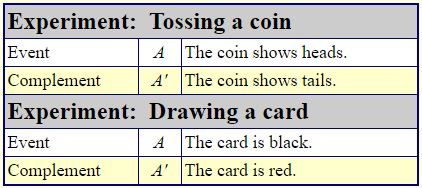Complement of an Event
If A is an event within the sample space S of an activity or experiment, the complement of A (denoted A’) consists of all outcomes in S that are not in A.
The complement of A is everything else in the problem that is NOT in A.
Consider these experiments where an event and its complement are shown:
 The probability of the complement of an event is one minus the probability of the event.
The probability of the complement of an event is one minus the probability of the event.
Complement:
P(A’) = 1 – P(A)
Example 1: A pair of dice are rolled. What is the probability of not rolling doubles?
Solution:
There are 6 ways to roll doubles.
P(doubles) = 6/36 = 1/6
P(not doubles) = 1 – 1/6 = 5/6
Example 2: A pair of dice are rolled. What is the probability of rolling 10 or less?
Solution: The complement of rolling “10 or less” is rolling 11 or 12.
P(10 or less) = 1 – P(11 or 12)
= 1 – [P(11) + P(12)]
= 1 – (2/36 + 1/36) = 33/36 = 11/12
Example 3: A gumball machine contains gumballs of five different colors: 36 red, 44 white, 15 blue, 20 green, and 5 orange. The machine dispenser randomly selects one gumball. What is the probability that the gumball selected is:
(a) green?
(b) not green?
(c) not orange?
(d) orange?
(e) not a color in the flag of the USA?
(f) red, white, or blue?
Solution: There are 120 gumballs in total in the machine.
(a) the probability of green is 20/120 = 1/6.
(b) the probability of not green is 1 – 1/6 = 5/6.
(c) the probability of not orange is 1 – P(orange) = 1 – 5/120 = 1 – 1/24 = 23/24.
(d) the probability of orange is 1/24.
(e) find part f first and then use the complement. 1 – 19/24 = 5/24.
(f) the probability of red, white or blue is 36/120 + 44/120 + 15/120 = 95/120 = 19/24.
